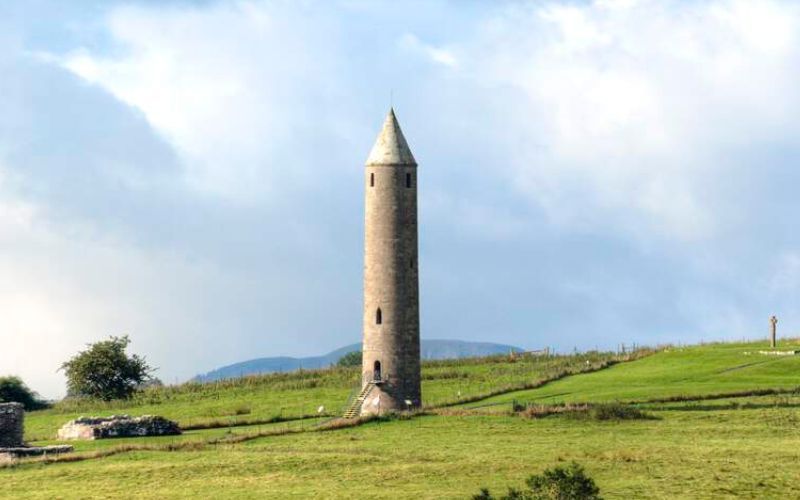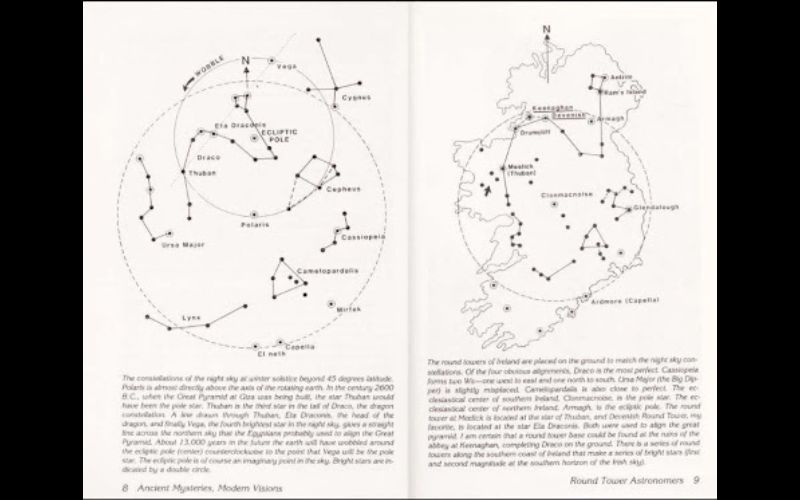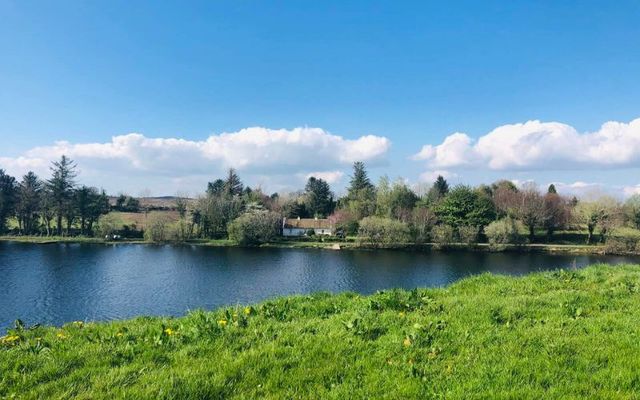The Belleek Community is currently waiting for the planning decision from the Fermanagh and Omagh District Council to see if Keenaghan Abbey in Co Fermanagh will be protected, but could there be a lost Irish round tower at Keenaghan Abbey?
This Irish heritage site is one of the oldest churches in Ireland and is “currently under attack from the proposed development of a glamping pod site with large amenity buildings and a car park for almost 100 vehicles that will destroy the natural environment and desecrate the historic landscape.”
I recently wrote an article for IrishCentral about my family’s connection to Keenaghan with the intent to highlight the abbey’s history as well as the efforts of Lisa McWilliams at Keenaghan Cottage and Stephen Heron at Belleek History Society as they actively seek to protect Keenaghan Abbey.
The article resulted in support from the award-winning chartered Landscape Architects with Park Hood. The Directors of Park Hood, Stuart Hood and Andrew Bunbury, prepared a comprehensive landscape report that advocates for the protection of Keenaghan Abbey. Their help is a testament to their character and to the integrity of their well-established Landscape Architectural practice.
Considering that this proposed development has put the spotlight on Keenaghan, I have rediscovered Irish American, Dr. Philip S. Callahan, and his scientific research on Keenaghan Abbey.
Dr. Callahan was stationed as a radio technician near Belleek during World War II at an outpost radio range transmitter site. As he states, “Our anti-submarine radio station was not 300 yards from that ancient graveyard site. I could see it from the windows of the hut where we lived in World War Il” (p.14).
Dr. Callahan conducted fascinating research which he explains in his 1984 book, "Ancient Mysteries, Modern Visions: The Magnetic Life of Agriculture." His essential thesis argues that “The round towers of Ireland are placed on the ground to match the night sky constellations” and that they have a healthy impact on the magnetic life of the agricultural landscape.
According to Dr. Callahan, the Celtic monks and their skilled stone masons built Keenaghan Abbey and possibly a round tower as one of their “stone observatories at earth's harmonious points.”
As a respected scientist, Dr. Callahan addresses the two commonly misheld theories about the function of Irish round towers: “Theory has it that the towers were built for protective sanctuary from Viking attacks. Another theory is that they were monastery bell towers.
"I have always considered both explanations to border on the ludicrous. Large bells were not cast until the Middle Ages (except in China), and the Viking attacks began long after the tower-building seventh century. The monks were hardly that prophetic!” (p.3).
His refutation is grounded from the empirical perspective that a simple scientific analysis that he performed demonstrates that a protective sanctuary and bell tower are unlikely and structurally illogical. The fundamental nature of his research presents that there is a correspondence between the terrestrial and the celestial at Keenaghan Abbey. This correspondence also occurs with many other Irish round towers such as Clonmacnoise in Co Offaly and Devenish in Co Fermanagh. These historical sites are protected and fortunately have never been threatened by irresponsible development.

Devenish Island Lower Lough Erne. (Ireland's Content Pool)
Keenaghan Abbey is believed to be the missing part of the Draco constellation as Dr. Callahan details in his study. After he plotted the geographical positions of many Irish round towers, he determined “where the missing Draco star would fall” on his Irish Ordnance Survey map (p.14). Keenaghan Abbey “was a magic spot” because it completed the constellation map of Draco on the ground (p.14).
Through Dr. Callahan’s extensive research on magnetic forces, he links St. Patrick’s Lough Derg to the saint who founded Keenaghan: “It will be noted that the sacred Lough Derg, where St. Patrick is believed to have meditated (figure 3, top right center), and its surrounding hills (seven clear, contoured mountains) is almost white with the force lines, and that from this area long lines of paramagnetic force sweep south to Breesy Hill (lone contoured mountain). They concentrate right at Keenaghan Lake where the ancient Celtic Abbey and healthy area lies” (p.25).

Dr. Callahan describes this relationship between the stars and Irish round towers as one “Of the four obvious alignments. Draco is the most perfect. Cassiopeia forms two Ws—one west to east and one north to south. Ursa Major (the Big Dipper) is slightly misplaced. Camelopardalis is also close to perfect. The ecclesiastical center of southern Ireland. Clonmacnoise, is the pole star. The ecclesiastical center of northern Ireland. Armagh, is the ecliptic pole. The round tower at Meelick is located at the star of Thuban, and Devenish Round Tower, my favorite, is located at the star Eta Draconis. Both were used to align the great pyramid” (p.9).
Dr. Callahan concludes that the Celtic monks and their stone mason architects were purposely imaging the night sky on the ground and asserts “I am certain that a round tower base could be found at the ruins of the abbey at Keenaghan, completing Draco constellation” (p.9).

Love Irish history? Share your favorite stories with other history buffs in the IrishCentral History Facebook group.
After WWII, Dr. Callahan returned to the US to continue his studies. He had only spent several years at Keenaghan, but it left an indelible impression upon him for the rest of his life, and especially on his research. As the years passed, the whereabouts of this lost round tower still remain a mystery.
Regardless of whether there are remains of a round tower around Keenaghan Abbey, Dr. Callahan’s pioneering research further emphasizes the importance of the historic landscape and the natural environment as emphasized by Lisa McWilliams at Keenaghan Cottage, Stephen Heron at Belleek History Society, the Historic Environmental Division (HED) and the landscape architects with Park Hood.
Moreover, there is also the Belleek community, as well as the thousands of Irish people who have signed the petition, and all emphatically agree that Keenaghan Abbey needs to be protected. Out of anyone who has peacefully fished in Keenaghan Lough, peacefully ambled around the abbey, and peacefully enjoyed Keenaghan Cottage, all will testify to the peaceful ambience of Keenaghan.
Dr. Callahan’s research also speaks to this peaceful place, as he poetically expresses in his book that “On more than one day I had walked down to that mystic place and sat among its tombstones and thickets watching the curlews and shore birds that landed along the banks of nearby Keenaghan Lough. Keenaghan is a beautiful little lough that sits astride the border of Northern Ireland. It was a spot where a 20-year soldier could dream the long, long thoughts of youth; a wild, lonely, magnetic place that collected the winds from the slopes of the Breesy Mountain and rolled them up the Valley of the River Erne.”
He further talks about the magic of Keenaghan and Breesy Hill “where I often went to revive my spirits during World War Il” (p.123).
If this proposed development is approved, there will never again be an experience like Callahan’s where one’s spirits can be revived, and sadly this peace will be lost.
Keenaghan “was a sacred Celtic spot and it, of course, eventually must have become a monastery” (p. 15). Dr. Callahan further reaffirms that “I will be willing to bet that if one were to search carefully the grounds of the old Keenaghan graveyard, buried somewhere at the edge of its crumbling stone wall is the base of a round tower” (p.15).
As for the mystery of this round tower that remains to be discovered, I know for myself I read Dr. Callahan’s book before I emigrated to the US, and I was initially skeptical, thinking that this research could be pseudoscience. I changed my mind when I perceived the actual science in his credible study, and I noted Dr. Callahan’s prestigious career as an academic and scientist.
One cool autumnal day when Keenaghan Lough’s water mirrored a Yeatsian still sky, my father, John, and I did have a chance to try to search for the foundational remains of a round tower. Although we had no luck that day as it neared the curlew’s twilight, we both mutually felt that ancient magnetic energy around Keenaghan Abbey as many who venture there do.
The energy charged through the stone walls both seen and unseen, rippled across the lough and resonated through the agriculturally rich and lush green fields abounding in flora and fauna that surround it. I can now relate to Dr. Callahan’s experience because it was a peaceful place where I, too, as a 20-year-old could “dream the long, long thoughts of youth; a wild, lonely, magnetic place."
As an ancient site and one of the oldest churches in Ireland, maybe there is a lost Irish round tower to be found there at Keenaghan Abbey. I thank my cousin, Joseph, and my father again for bringing Dr. Callahan’s scientific research in "Ancient Mysteries, Modern Visions: The Magnetic Life of Agriculture" to my attention. I would imagine every Irish person who reads this article would be curious to know about another possible understanding of the function of Irish round towers, grounded in scientific analysis now within the growing scientific field of archeoastronomy. We know Newgrange in Co Meath, Stonehenge, and the Pyramids of Giza are all aligned to star constellations, solstices, and equinoxes, so it makes sense to think that some of these early Irish abbeys and their round towers have a connection to the stars, too.
So, while the Belleek community waits on a decision from the Fermanagh and Omagh District Council to see if Keenaghan Abbey will be protected—we as Irish people here and afar can all realize the paramount importance of preserving peaceful places, especially given the troubled waters of Irish history.
For there is no monetary profit on a place of peace, for there is no price point on a place of peace—for a place of peace— just like the one around Keenaghan Abbey is perpetually priceless.
*Eamon O'Caoineachan, originally from Co Donegal, received his Masters in Irish Studies at the University of St. Thomas in Houston and now works as a freelance writer and poet.




Comments